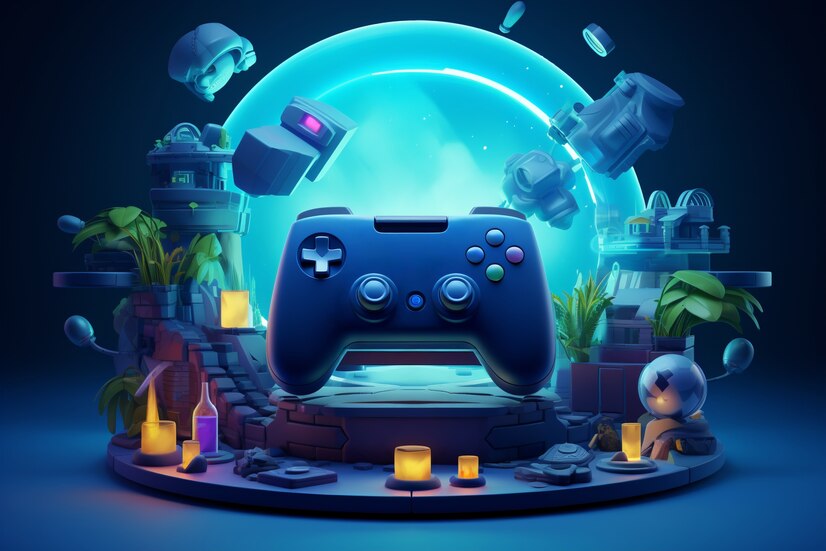The fields of game development continue to develop progressively so the expected transformations in 3D game development for 2025 show strong indicators of major advancement. The boundary development activities of programming teams result in innovative artistic approaches that transform gameplay encounters. The forthcoming years suggest excellent potential for 3D game development which will include both photo-realistic visual appearance and design choices that break artistic conventions. This article evaluates forthcoming game art directions for 3D games in 2025 while describing sector transformations and upcoming developer considerations.
1. Hyper-Realistic Graphics
Realistic graphics engineering remains dominant within 3D game development because its importance will continue growing throughout 2025. The advancement of GPUs and real-time ray tracing alongside AI-controlled rendering methods enables developers to access hyper-realistic visual effects more easily in their games.
Why It’s Trending
Current game development studios invest resources to develop authentic virtual spaces that pair with authentic player models alongside practical game physics behavior. When used for this purpose the technology deepens player involvement in simulated gameplay while creating an experience that resembles watching an interactive film. The high standards of realism in 3D game acceleration exist due to AAA releases including “The Last of Us Part II” and “Cyberpunk 2077“.
Challenges & Opportunities
The realistic artistic approach necessitates ample production resources so it poses difficulties for studios that operate independently. New AI technologies together with optimized development frameworks create better prospects to produce first-rate game assets. The approaching year 2025 will see game developers integrate hyper-realistic graphics to develop better stories and cinematic sequences.
2. Low-Poly & Minimalist Aesthetics
Low-poly art continues dominating 3D game development since it delivers both effectiveness and artistic charm. Visual striking games that maintain lightweight create their effects through geometric shapes and minimal textures with this specific art style.
Why It’s Trending
Indie game developers favor this style due to its cost-effectiveness and unique visual appeal. Games such as “Journey” together with “Firewatch” show that low-poly appearance and smooth operation can exist together beautifully in video games.
Challenges & Opportunities
Expressive engagement remains the main difficulty in working with a low-poly artistic style. The development of 3D tools now enables developers to implement lighting effects together with shaders which increase scene visual depth. Mobile and independent video game studios will invest more in low-poly visual styles during 2025 because their efficiency and artistic capabilities fit both markets perfectly.
3. Cel-Shaded & Comic Book Aesthetics
Cel-shading represents another common artistic choice within 3D game creation because it enables hand-drawn and comic-inspired visual effects. Game developers have brought forward the cel-shaded trend through the success of Borderlands as well as the Legend of Zelda: Breath of the Wild leading to continued popularity in 2025.
Why It’s Trending
Development studios use cel-shaded graphics because of their animated and colorful appearance which serves as an appealing stylistic element for their work. Through its artistic techniques developers acquire freedom to create while minimally requiring intensive textures in their work.
Challenges & Opportunities
The development of games faces the difficulty of striking an appropriate level of simple visual elements while maintaining detailed content. The progress of modern 3D rendering and shading technology enables cel-shading to continue as an available artistic tool for creating distinctive video games in 2025.
4. Voxel-Based Art Style
Game developers successfully draw inspiration from the Minecraft-style block structures to continue creating voxel art in their projects. Voxel-based art design will become a major trend in 2025 because of its compatible modular structure.
Why It’s Trending
World-building alongside procedural generation within voxel-based games makes them suitable choices for building worlds in sandbox and simulation genre games. The blocky simplicity which makes them visually pleasing also enables easier development and optimization abilities.
Challenges & Opportunities
Game developers face the main difficulty of preventing market saturation when working on voxel-based 3D games. Developers who want to stand out in the market need to use groundbreaking mechanics together with dynamic settings. In 2025 you can anticipate the return of creative voxel-based games because more development tools are adding support for voxel rendering.
5. Photorealistic Stylization (Hybrid Approach)
The 3D game development industry is adopting a stylistic combination with realistic elements as its main aesthetic approach. Any 3D game developer employs this technique by integrating professional textures alongside artistic visual enhancements of fantasy ideas to achieve realistic but fantastical visual outcomes.
Why It’s Trending
The fusion of graphic beauty and artistic independence serves as a common theme between “Horizon Zero Dawn” and “Final Fantasy VII Remake.” The implemented balance lets developers make deep gameplay experiences although they do not face restrictions from realistic representations.
Challenges & Opportunities
Developers need to uphold artistic cohesion while extending game-developing limitations. Thankfully new rendering capabilities along with AI-based artifact generation make this combined method increasingly practical. A large number of 3D games will adopt artistic realism in their gameplay and visual presentation by 2025 to create compelling gaming experiences.
Conclusion
In 2025 game developers will use realistic visual approaches along with artistic style and creative visual elements for their 3D game projects. Technological progress will offer game developers expanding resources to make their games even more entertaining to the eyes. Game art will continue to grow with potential development across realistic visual displays and stripped-down minimalistic representations of artwork. Contact us for more details.
Frequently Asked Questions

1. The dominant artistic technique for three-dimensional games during 2025 remains undefined.
Hyperrealistic graphics have emerged as the leading artistic choice for 3D game development until 2025 because of the advancement of AI rendering together with real-time ray-tracing capabilities. The combination of cel-shading and low-poly styles continues to find support since they offer exclusive visual attractiveness along with optimization optimizations.
2. What makes low-poly art fashionable during the year 2025?
The 3D game development sector maintains its use of low-poly art because this artistic style offers affordable production along with high-speed graphics and visual attractiveness. Indie game developers actively use this visual style because their unique artistic essence works well with any level of device performance.
3. Cel-shaded graphics operate as a powerful tool which benefits 3D game development through what process?
Cel-shaded graphics improve 3D game development through their expressive artistic design which makes them unique compared to hyper-realistic games. This method delivers perfect results in gaming to achieve either comic book or animated effects through artistic freedom.
4. The Council can predict whether voxel-based games will continue to matter in the gaming industry during 2025.
The procedural capabilities and modular format of voxel-based games make them important contributors to the modern 3D game development industry even during the year 2025. The gameplay elements of world-building together with player creativity make these genres popular for voxel-based games.
5. AI technologies will modify 3D game art design standards in the year 2025.
Game development through 3D sees revolutionary improvements through AI technology which generates textures effectively automates asset development and improves performance when rendering. AI aids developers to test various artistic styles and lowers both development period and expenses which makes it simpler to produce high-quality visuals.
3D game development will pursue extreme visual diversity in 2025 thus expanding beyond current rapid evolutionary trends. Game developers face an exciting professional journey toward building immersive stunning virtual worlds by adopting various graphic styles including hyper-realism cel-shaded voxel-based or hybrid combinations.

